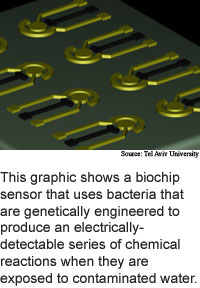
Bacteria
drive biochip sensor
Researchers are working
to connect living cells to computer chips to gain the best of both worlds.
Living cells are terrific sensors, and can also be used to evaluate and
emulate biological behavior, while electronics are exemplary at serving
up data.
Researchers from Tel Aviv University in Israel have built an electrochemical
nano-biochip that detects toxic water.
It could eventually be used to detect pollution and chemical warfare
threats, according to the researchers.
The chip connects electronics with genetically-engineered bacteria
that respond strongly to environmental stress. The advantage of using
bacteria to detect toxicity is the bacteria are non-specific detectors,
meaning they will react to any substance that causes them harm.
The researchers' proof-of-concept chip joins the electronics with
the bacteria using an electrochemical interface. The bacteria's reaction
to the presence of a toxic substance triggers a series of chemical reactions
that results in an electrical signal being detected by electrodes on the
chip.
The device is portable, relatively inexpensive, handles 100-nanoliter-size
water samples, and evaluates water toxicity in about 10 minutes. A nanoliter
is one millionth of a milliliter. There are about 5 milliliters to a teaspoon.
The method could be used in practical applications within a year,
according to the researchers. The work appeared in the June 8, 2005 issue
of Nano Letters (Novel Integrated Electrochemical Nano-Biochip
for Toxicity Detection and Water).
Stories:
Traffic model maps congestion
Fingernails store data
Quantum crypto scheme doubly fast
How It Works: Internet Structure
Briefs:
Baited molecule fights cancer
Bacteria drive biochip sensor
System brightens dark video
Micro fuel cell packs power

Research Watch blog
View from the High Ground Q&A
How It Works
RSS Feeds:
News
Ad links:
Buy an ad link
Ad links: Clear History
Buy an ad link
|
TRN
Newswire and Headline Feeds for Web sites
|
© Copyright Technology Research News, LLC 2000-2010. All rights reserved.